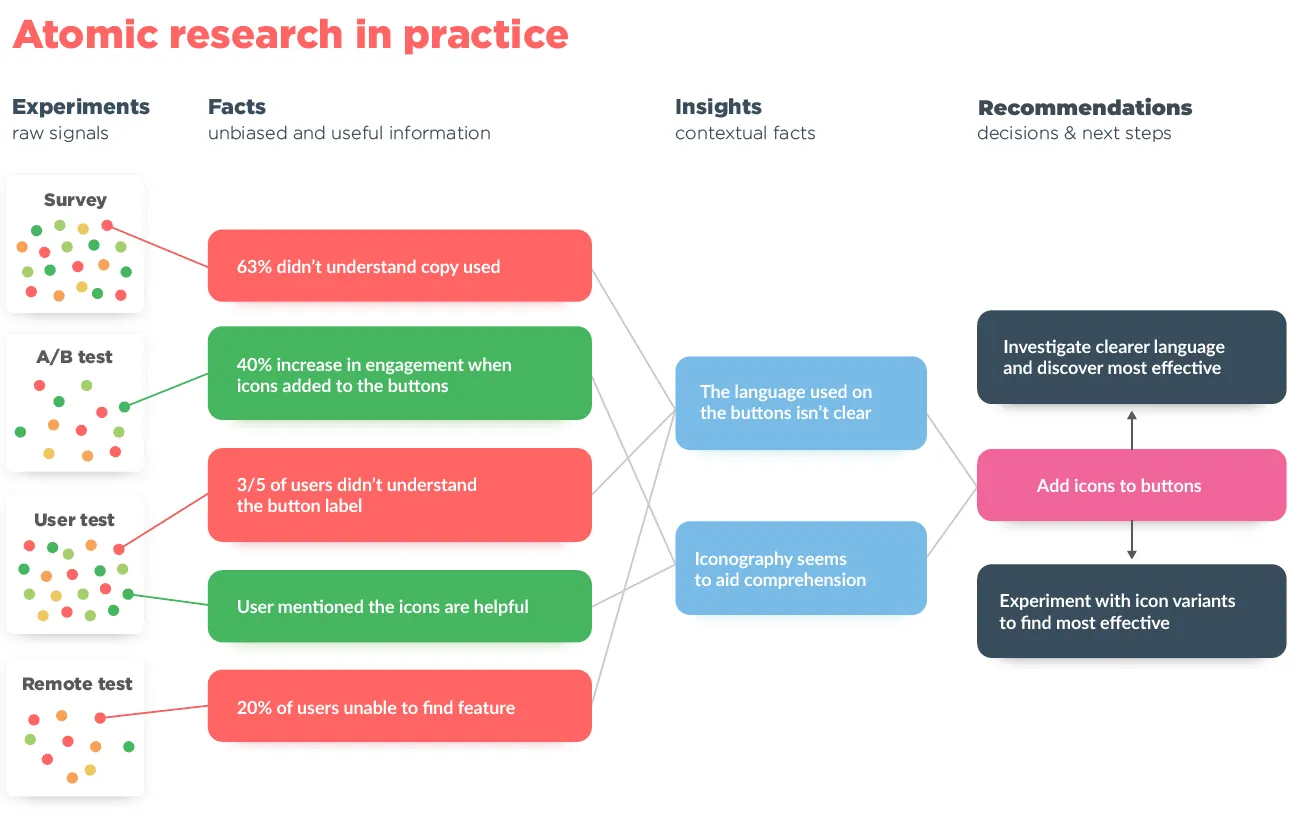Qu'est-ce que l'Atomic Research ?
L'Atomic Research est une méthodologie qui permet d'organiser les informations recueillies par le biais de la recherche utilisateur. L'objectif est de fournir des recommandations très fiables, afin de prendre des décisions plus pertinentes. Elle vous permet d'anticiper les besoins futurs et, en fin de compte, d'améliorer la satisfaction globale des clients. Découvrons cette méthodologie.
L'Atomic Research en pratique
L'Atomic Research décompose les connaissances acquises auprès des clients en quatre éléments :
les expériences
les faits
les apprentissages
les recommandations
En pratique, une recommandation inclue des expériences, des faits et des apprentissages. concrètement, voilà ce que cela donne :
"Nous avons mis en place un test utilisateur et un test à distance (expériences),
nous avons constaté que 3 utilisateurs sur 5 ne comprenaient pas le libellé et que 20 % des utilisateurs étaient incapables de trouver la fonctionnalité (faits),
ce qui nous fait penser que le langage utilisé sur les boutons n'est pas clair (apprentissage)
donc nous allons ajouter des icônes aux boutons (recommandation)."
Examinons plus en détail les choses :
"Nous avons mis en place des [expériences]..." - Une expérience est un ensemble d'"interactions utilisateur". Il s'agit d'un point de données (une connexion dans un outils d'analytics ou un clic sur une interface A/B testée) pour la recherche quantitative ou d'un verbatim (une citation extraite d'un texte non structuré) pour la recherche qualitative.
"...nous avons constaté que [faits]..." - Un fait est une déclaration décrivant ce qui a été découvert sur la base des interactions avec les utilisateurs (points de données ou verbatims). Les faits ne reposent sur aucune hypothèse et ne doivent jamais refléter une quelconque opinion.
"...ce qui nous fait penser que [apprentissages]..." -Un apprentissage est une phrase qui interprète les faits que l'on a choisi. Un apprentissage est lié à un ou plusieurs faits, même s'ils proviennent de plusieurs expériences différentes. Certains faits peuvent également infirmer un apprentissage.
"...donc nous allons [recommandations]." - Une recommandation est une phrase présentant des solutions pertinentes basées sur un ou plusieurs apprentissage. Plus il y a d'apprentissages liés aux recommandations, plus les preuves de leur pertinence sont solides. C'est particulièrement utile pour prioriser le travail.
Les origines de l'Atomic Research
L'Atomic Research, introduite par Daniel Pidcock en 2018 et inspirée des principes de l'Atomic Design, vise à cadrer la connaissance issue des clients. Son principe est basé sur le fait de partir du plus petit élément : l'atome. Ces atomes sont ensuite assemblés en molécules, formant ensuite des organismes.
L'atome est une interaction utilisateur. Il s'agit d'un point de données pour la recherche quantitative ou d'un verbatim pour la recherche qualitative. Ils sont stockés dans une expérience.
La molécule est un fait, constitué de plusieurs interactions utilisateurs (atomes).
L'organisme est un apprentissage, basé sur un ou plusieurs faits (molécules).
Le dernier élément est une recommandation, basée sur plusieurs apprentissages (organismes).
Sans apprentissages, pas de recommandations.
Sans faits, pas d'apprentissages.
Sans verbatims ou points de données, pas de faits.
La beauté de l'Atomic Research réside dans le fait qu'elle impose une réflexion fondée sur des données prouvées. Sans apprentissages, pas de recommandations. Sans faits, pas d'apprentissages. Sans verbatims ou points de données, pas de faits.
Ca encourage les gens à passer du temps à creuser les données, tant qualitatives que quantitatives, à les trier et à les thématiser. Ils créent ainsi une base solide de connaissances pour l'ensemble de l'organisation.
En bref, l'Atomic Research ajoute de la crédibilité aux apprentissages en dévoilant leur provenance à chaque fois. Elle renforce la confiance dans les recommandations, permettant aux équipes de donner au feedback client la place qui lui revient : au centre du processus de décision.
Selon Daniel Pidcock, les entreprises réduiraient ainsi la création de rapports d'environ 60 à 70 %, ce qui leur permet de passer davantage de temps sur la collecte et l'analyse.
La plupart des équipes internes réduisent leurs créations de rapports d'environ 60 à 70 %.
Comment les entreprises ont-elles adopté l'Atomic Research ?
Les entreprises commencent à adopter des outils numériques pour appliquer cette méthodologie à leurs données. Elles cherchent à organiser et à partager l'information pour l'ensemble de l'organisation. Nous voyons ainsi l'émergence de deux types d'outils :
Les outils de low-code comme Notion, Airtable ou Coda. Ils permettent aux UX researchers d'organiser les données comme ils le souhaitent, en utilisant des tables pour chaque composants spécifiques de la recherche Atomic. Ils leur permettent également de construire facilement des tableaux de bord personnalisés pour d'autres partenaires (Product managers, Product designers...).
Les outils UX de taggage de texte comme Dovetail ou condens. Ils permettent aux UX researchers d'organiser les données qualitatives de manière efficace, grâce aux fonctions de tag, ainsi que de construire des insights. Ils fournissent des tableaux de bord génériques sur les verbatims et les insights.
Comme expliqué précédemment, les atomes sont associables à des verbatims et à des points de données. L'idée principale dans l'Atomic Research est d'offrir une méthodologie permettant de mélanger des données quantitatives et qualitatives afin de renforcer les apprentissages. Cette méthodologie est d'ailleurs conçue pour être utilisée à grande échelle, puisque sa structure s'y prête particulièrement bien.
Mais quand on regarde plus en détails comment est utilisée l'Atomic Research, on constate que cette méthodologie ne réussit pas à passer à l'échelle. En France, plusieurs entreprises ont abandonné l'Atomic Research pour trois raisons principales:
L'extraction de verbatims à partir de textes non structurés nécessite des ressources trop importantes, car tout est fait à la main.
Les outils existants ne parviennent pas à intégrer de manière efficace les données quantitatives et qualitatives, ce qui limite la profondeur de l'analyse.
Implémenter des outils low-code à grande échelle pose des défis trop importants.
En France, l'Atomic Research n'arrive pas à passer à l'échelle.
C'est pourquoi nous avons lancé Synopsis, une solution numérique permettant d'exploiter vos connaissances sur les clients. Cette solution utilise l'IA pour trier et thématiser automatiquement les interactions des utilisateurs, elle construit des insights pertinents mélangeant des données qualitatives et quantitatives et elle est utilisable par l'ensemble de l'organisation de manière fluide. Notre objectif est de rapprocher les entreprises de leurs clients, ce qui est finalement le but de toute entreprise orientée client.
Sources
Demandez une démonstration - Synopsis
What is Atomic UX Research? - Daniel Pidcock
Foundations of atomic research - Tomer Sharon
Introduire la priorisation RICE au cœur de l'Atomic Research - Yolaine Mercier et Michael Baeyens
Atomic research in the European Commission — a UX case study - Pedro Almeida

